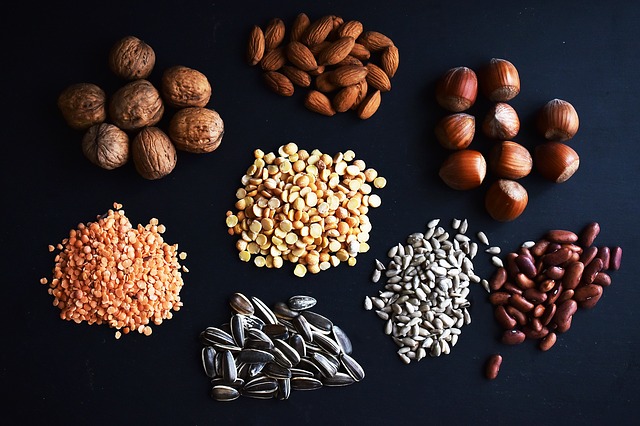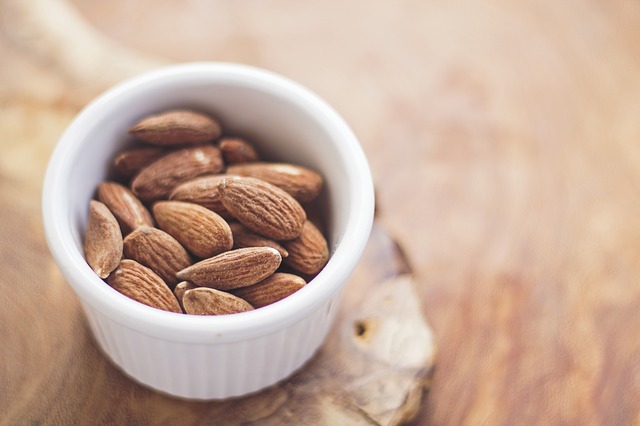Brazil nuts are named that for a reason. Brazil nut trees are found forests of Brazil, Bolivia, and Peru. They are one of the long living and tallest trees in all the tropical rainforests, thought to live about 500 to 700 years. Each mature tree bears up to 300 fruit pods in a season.
There is only 1 species of bee that pollinates these flowers and those bees are only found in the presence of a particular orchid. Therefore Brazil nuts will only be produced in rainforests that also have this orchid.
Animals like the agouti are what is needed for the trees to seed themselves. The pod is a large shelled fruit, similar to the coconut. It takes about 14 months to mature after pollination. Each fruit features 10-25 seeds arranged in orange-like segments. Each nut is then encased within its own thick dark-brown color individual shell.
Health Benefits of Brazil Nuts
Brazil Nuts are an excellent source of mono-unsaturated fatty acids (MUFA) like palmitoleic acid (16:1) and oleic acid (18:1) that helps to lower LDL or “bad cholesterol” and increases HDL or “good cholesterol” in the blood. They are a very good source of vitamin-E; contain about 7.87 mg per 100 g
Brazil nuts contain exceptionally high levels of selenium, a powerful antioxidant. 100 g nuts provide about 1917 µg of selenium and 3485% of recommended daily intake making them as the highest natural source of this mineral. Adequate selenium foods in the diet help prevent coronary artery disease, liver cirrhosis, and cancers. Too much selenium can be a problem too so only small amounts of this nut are needed if eaten on a daily basis.
They are an excellent source of B-complex group of vitamins such as thiamin (51% of RDA per 100 g), riboflavin, niacin, pantothenic acid, vitamin B-6 (pyridoxine) and folates.
They contain very helpful amounts of other minerals such as:
- copper
- magnesium
- manganese
- potassium
- calcium
- iron
- phosphorus
- zinc
Copper helps prevent anemia and bone weakness (osteoporosis). Manganese is an all-important co-factor for an antioxidant enzyme, superoxide dismutase.
How To Use Brazil Nuts
Brazil nuts are available raw (with shells and without), roasted and salted in the stores. Since the nuts are high in polyunsaturated fats, they turn rancid and deteriorate quickly if they remain exposed to air, humidity, and sunlight. It is recommended to purchase unshelled nuts and shell as needed to get the edible nut.
Brazil nuts are also pressed for their oil, which can be used in cooking and as a skin lubricant.
The recommendations I found were to have just a few Brazil nuts twice or three times per week due to the risk of selenium toxicity and overweight.
The best option I found for unshelled Brazil nuts is from Nuts.com. (Most of us reading this post probably don't live near a rainforest so there is not an option to buy these local.)
Selenium is something I have been wanting to supplement in my diet so I am inclined after researching this nut to order some and add in a few Brazil nuts to my diet each week. What about you? Do you eat Brazil nuts at all? Does this information here make you inclined to change that if you don't?
- Are Pasteurized Almonds Good or Bad? - January 31, 2022
- Nutrition of Peanuts - November 20, 2013
- Happy With Hickory Nuts - November 13, 2013



Do you know the best sheller for brazil nuts? I have heard that they are difficult to shell.
I am sorry but I don’t know the answer to that. I suggest some more research.
Yum! Thanks for all the info! And thanks for linking up to Wellness Wednesdays!
Thanks for the healthy advice 😉
Not particularly Brazilian nuts, but I love nuts in general. Nuts give you a tasty dose of healthy diet. Isn’t it amazing to have something which ensures awesome taste along with super health secrets.